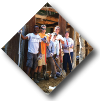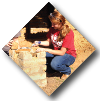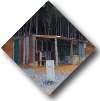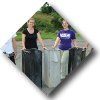Employing Available Resources to Transform Health
The College of Public Health at East Tennessee State University started a program in 2011 to teach the skills needed to protect and promote health and well-being in resource-limited settings. The need to provide public health services in resource-limited settings exists in both wilderness and isolated settings and when a disaster disrupts basic societal infrastructure. In these settings, lives may depend on the ability to provide water, sanitation, hygiene, shelter, first aid, and other basic services.
Why?
As the first school of public health located in central Appalachia, graduates of the college work in rural and medically underserved communities that have inadequate housing and lack basic sanitation and hygiene. Several students, following field experiences in rural parts of Africa, reported they did not have the practical skills to reliably provide clean drinking water. Additionally, the college was motivated by reports of increased mortality occurring after natural disasters because working professionals in affected areas could not provide basic public health services.
Where?
Project EARTH is hosted at the ETSU/Eastman Valleybrook Campus in the beautiful mountains of northeast Tennessee.

What?
Project EARTH currently includes 3 interconnected components: academic coursework, a simulation facility composed of replicas of actual homes from resource-limited areas, and a creative component focusing on encouraging innovation. To groups outside the college, Project EARTH offers a series of half- to multi-day intensive immersion experiences that introduce participants to a clustered set of related skills.
The main academic course is a 15-wk, 3-credit-hour course required for all students in the bachelor of public health and bachelor of health administration degree programs, as well as those in the global health and development minor and the disaster preparedness minor. It teaches students to use basic tools and to make basic products while focusing on developing teamwork, creativity, and resilience.
There is also a required course for all doctor of public health students that stresses teamwork and innovation within the framework of resource-limited settings. The class challenges students to make a variety of products from recycled or repurposed materials while working together to address the public health needs of a simulated resource-limited community.
How?
Working in a resource-limited setting requires effectively utilizing locally available resources to improve and protect people’s health and well-being. Project EARTH focuses on teaching students to design and create specific products for these situations while progressively honing those cross-cutting skills necessary to work effectively in these settings—notably teamwork, creativity, and resilience. To this end, Project EARTH implements a sequential learning process that includes significant hands-on training and simulated experiences with debriefing opportunities at the end of each activity.
When?
Over the last decade, the college expanded the program considerably into what is now known as Project EARTH (Employing Available Resources to Transform Health) that now includes several different academic courses as well as programs designed to develop innovative solutions to address the needs of people in resource-limited settings.
Lessons from 10 Years of Teaching Public Health Skills
 Stout Drive Road Closure
Stout Drive Road Closure 



